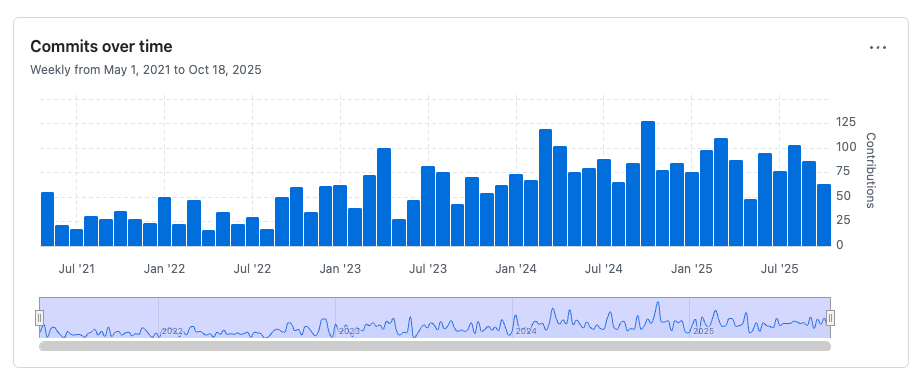Thank You for Making GrowthBook the World’s Largest Open-Source Experimentation Platform
GrowthBook passed 7,000 stars on GitHub this month thanks to you. Your support confirms our commitment to experimentation-led development and open-source transparency. We see you testing every day in the 100 billion+ feature flag look ups we handle, and the 2,600 organizations actively using GrowthBook each month.
To celebrate this milestone, let’s look back on how we’ve grown and ahead to where we’re going. Our goal is to help you go faster at scale. Let’s see how we do it.

What’s New with GrowthBook in 2025?
GrowthBook released more than 45 new features in our cloud and self-hosted experimentation platform in 4 key areas: data exploration, developer experience, advanced experimentation, and improving the experiment lifecycle with AI. As an engineering-first company, we believe that experiments should be easy and cheap to run so you can learn constantly.
Better Data Exploration
What good is an experiment if you can’t easily analyze the results? GrowthBook provides full transparency by exposing the underlying SQL for your experiments. But we know you wanted more ways to explore your data, debug issues, and create custom reports and visualizations without the context switching. Now you can explore your data and build custom dashboards.
Complexity happens fast when it comes to data analysis across teams and departments. Metric slices give everyone flexibility without complexity. For example, instead of separate revenue metrics for each product type, you can use metric slices to automatically generate distinct revenue metrics for each product type (such as “apparel” or “equipment”). Teams benefit from more granular and relevant analysis without duplicating definitions. Everyone stays on the same page.
Accelerating Experimentation Culture
Why do so many engineering teams build their own experimentation platforms? So they get exactly what they want. GrowthBook helps teams migrate from homegrown to an experimentation culture by giving developers what they want with control. Customizable dashboards and frameworks help more teams, run more experiments faster, and learn from the results.
That’s why we developed experiment dashboards. Developers, data teams, and product managers create their own custom view to go deep on individual experiments. They get exactly what they need to highlight interesting results, hide the noise, and begin to tell a story with the data that everyone in the organization can understand.
The Experiment Decision Framework helps teams make systematic, consistent decisions about when and how to conclude experiments. GrowthBook’s default modes include “do no harm” and “clear signal” with the option to customize with your own rules so you can iterate quickly.
For developers who want to skip setup of a data source for our warehouse native solution, we launched a Managed Warehouse option. Now, your team can go straight to feature management, experimentation, and product analytics without the data connection, cost, and refresh hassles.
Advanced Experimentation
The more experiments you run, the more advanced your experimentation program becomes. We believe that so many of you support GrowthBook because of the high bar we set for statistical rigor. We continued that commitment with features for sophisticated metrics, automated decision-making, and comprehensive measurement capabilities for high-frequency testing programs. Measure the long term impact of changes and control outcomes with holdouts, multi-arm bandits, and safe rollouts.
With Insights, GrowthBook’s executive dashboard offers a 10,000 foot view across all of your organization’s experiments to understand what you’ve done and what you’ve learned. Help your team go further, faster with learnings, experiment timelines, and explore metric effects and metric correlations. Filter by project and data range, view by win rate, scaled impact, and velocity.
Improving the Experiment Lifecycle with AI
It’s time to talk to your experimentation platform. The MCP server streamlines workflows, and enables AI-powered automation and insights within your development environment. Connect to your favorite LLMs to manage feature flags, experiments, and other tasks without switching contexts. The MCP server works with Cursor, Claude, VS Code, and it’s open source.
We’ve also embedded AI into GrowthBook. You can use natural language questions to generate SQL. Your GrowthBook assistant helps you follow best practices by checking hypotheses, summarizing metric descriptions, generating experiment summaries, and comparing past experiments to avoid duplication.
Looking Ahead: The Future of Experimentation at GrowthBook
We continue to be inspired by our GitHub stargazers, Slack community members, and all the experimenters out there, committed to making everything better. As we prepare for the year ahead, we’re looking at a few key themes.
- In this time of consolidation and disruption, data security and governance matter more than ever. Our warehouse-native approach allows you to keep your data in-house under your control.
- As AI-generated code becomes more pervasive, experimentation provides an essential check on whether code works and benefits the business.
- Fostering a culture of experimentation does more than draw the signal from the noise. It helps you fail sooner, in the smallest ways possible, so you can accelerate success.
Here's to the next 7,000 stars and beyond! If you haven't already, check out GrowthBook on GitHub—we'd love to see what you experiment with next.
Ready to join the experimentation revolution? Star us on GitHub, join our Slack community, or dive into the code. The future of product development is open, transparent, and data-driven. Let's build it together.







